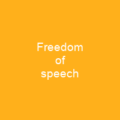Freedom for the Thought That We Hate: A Biography of the First Amendment
Imagine a world where every voice is silenced in fear and doubt—wouldn’t that be a terrifying place to live? This is exactly what Anthony Lewis explores in his 2007 non-fiction book, ‘Freedom for the Thought That We Hate,’ which delves into the evolution of civil liberties through key historical events.
The title itself is a powerful statement, drawn from Justice Oliver Wendell Holmes Jr.’s opinion that freedom for hate speech is more essential than any other principle of the Constitution. This book serves as a beacon in the stormy seas of censorship and repression, reminding us why we must protect even the most controversial thoughts.
Starting with the Basics
The First Amendment, which prohibits Congress from creating legislation that limits free speech or freedom of the press, is the cornerstone of this book. Lewis starts by quoting this fundamental clause, setting the stage for a deep dive into its implications and historical context.
James Madison, the writer of the United States Constitution, believed that freedom of the press would serve as a form of separation of powers to the government. This idea is crucial because it highlights how intertwined free speech and democracy are.
The Evolution of Free Speech
How can we possibly imagine a world without the right to speak freely?
Throughout history, fear has often led to overreaching acts by governments. Lewis recounts key events where fear was used as an excuse for suppression of speech. For instance, in 1798, under President John Adams, the federal government passed the Alien and Sedition Acts, which deemed any false or malicious writing against the government a criminal act.
These acts were used to punish members of the Republican Party who criticized the government. When Thomas Jefferson was elected president in 1800, he issued pardons to those convicted under these laws, showing how public opinion can shift and influence policy.
The Supreme Court’s Role
During World War I, with increased fear among the American public, the First Amendment was given wider examination by the U.S. Supreme Court. Associate Justices Louis Brandeis and Oliver Wendell Holmes Jr., began to interpret broader support for freedom of speech imparted by the First Amendment.
In Schenck v. United States, Holmes wrote that freedom of speech must be defended except for situations in which ‘substantive evils’ are caused through a ‘clear and present danger.’ This case set an important precedent, but it also raises questions about when speech can be restricted.
Modern Applications and Challenges
How do we apply these principles to the digital age?
In contemporary times, media actions regarding privacy have changed public expectations. Lewis warns that during periods of heightened anxiety, free speech rights are at greater risk due to authorities’ attempts to suppress critical comment.
The central theme of the book is a warning about repression and suppression of dissent by government officials seeking to limit freedom of speech. Lewis highlights examples such as the use of fear to justify repression after the September 11 attacks, emphasizing that these actions undermine the very principles upon which America was founded.
Conclusion
The U.S. has unparalleled civil liberties, including freedom of speech and press. However, government action taken after events like 9/11 have reduced citizens’ freedoms. Lewis argues that criticism is essential to a healthy democracy, and the scope of civil liberties in the U.S. has increased over time due to people’s desire for freedom.
As we navigate through today’s complex world, ‘Freedom for the Thought That We Hate’ serves as a reminder of why protecting even the most controversial thoughts is crucial. After all, it is only by embracing and defending every voice that true democracy can thrive.

You want to know more about Freedom for the Thought That We Hate?
This page is based on the article Freedom for the Thought That We Hate published in Wikipedia (retrieved on November 30, 2024) and was automatically summarized using artificial intelligence.







